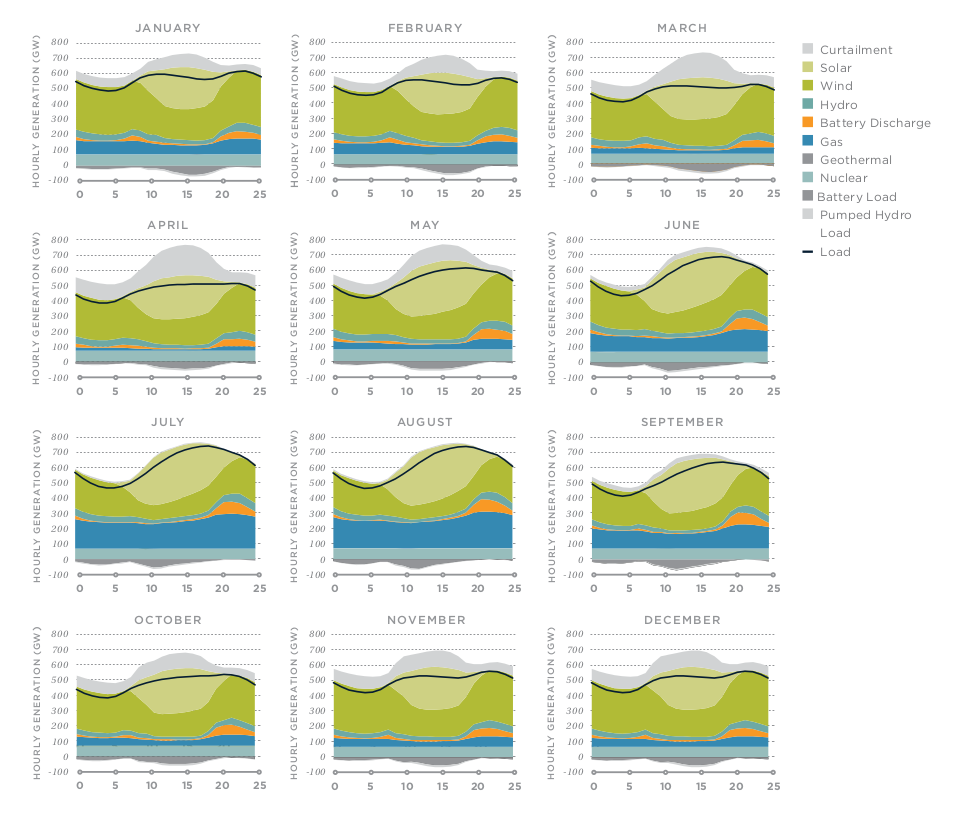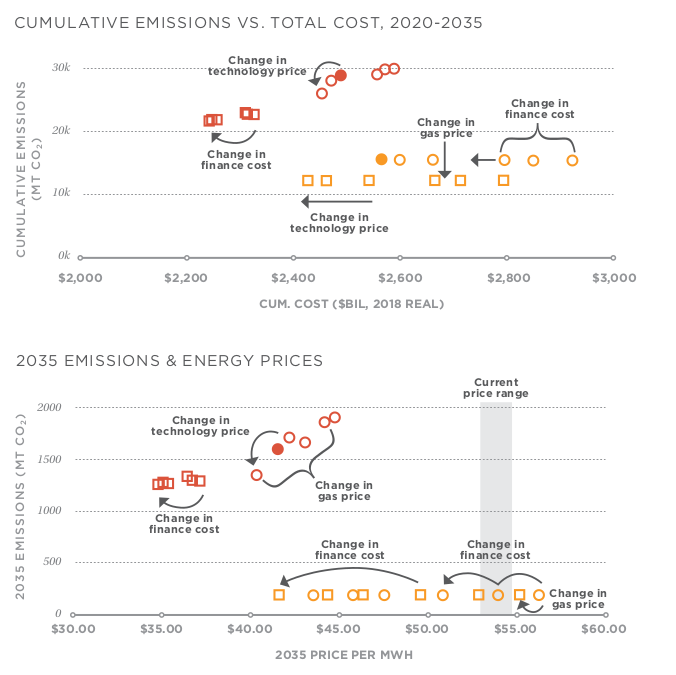The corner stone for reaching climate targets is building a clean grid.
What is the path to that grid?
The bulk of this post will draw on The 2035 Report from Berkeley. The report finds a working 90% clean grid that satisfies several critical constraints:
- Satisfy the 2035 US electric load with 90% clean power on an annual basis
- Use existing proven-at-scale technology
- Show a feasible path to construction
Shape of the clean grid
The report ultimately presents several grids, but they are variants on the same theme:
- Massive deployment of Solar Power, Wind and Batteries
- Keep the existing nuclear fleet
- Keep the existing gas fleet, but repurpose it for long lulls of wind and solar output
In 2035, this is where power would come from in an average day each month:

Path to get there
Because the plan uses existing technology, there is no “magic bullet” technical break-through needed. The path, on a technical level, is simple:
- Extensive and rapid expansion of wind, solar, and battery storage
- Stop adding new gas plants
- Extend transmission systems to effectively take advantage of renewable additions
The scale of the additions are large, but not beyond the pale. As you can see below we need to add about as much wind and solar per year as we added gas turbines in 2004.

Critical factors
You can think of the factors needed to make this happen in two groups:
- Policy that directly or indirectly drive change
- Cost of the rollout, primarily driven by Technology and Financing cost
Policy
You can read the full policy brief on the 2035 Report Webpage. The high level gist is:
- Adopt a Clean Electricity Standard reaching 55% carbon free by 2025, ramping to 100% by 2045
- Extend existing clean energy and production tax credits, including extending them to storage
- Support coal-dependent communities through the transition (both employees in the industry and rate-payers left with debt burdens from stranded coal assets)
- Invest in R&D to find the tech needed to get from 90% to 100% clean
The report also evaluates an alternative policy approach, a national carbon price. The finding here is that a national carbon price can reach the 90% clean goals, but is not certain to. How a price on carbon affects outcomes depends on how high that price is relative to other prices. (Citation: Phadke & al., p. 51) Phadke, A. & Wooley, D. (n.d.). 2035 Appendix. Retrieved from https://www.2035report.com/
How could hackers make a difference on policy?
- Participate in advocacy, as citizens
- Find ways to use our skills to amplify advocacy, doing things like https://cclcalls.org/
- Find ways to illustrate and explain the grid transition, to build support among voters
- Build systems to track progress and find regions or counties that need specific attention
Cost
Cost is less important than policy, because..
- If policy does not materialize, then even the most optimistic cost scenario evaluated does not come close to the necessary reductions in emissions; and
- If policy does materialize, then we meet the targets even if costs don’t change much from today.
In this chart the researchers show the impact on a no-policy case (red) and a new-policy case (orange), when various costs change.

Why care about cost, then? Well, presumably there is some feedback: Lower cost makes policy more achievable. It makes policy changes less costly to tax payers, and it makes the effects save rate payers money on their electrical bills.
There’s also a deeply optimistic view, which is this: The 2035 report relies on NREL predictions of future cost of solar and wind. NREL has been very wrong in their predictions of these prices so far, predicting much higher prices than what ultimately came to pass.
It could be that if the prices drop much more than the lowest case considered in the 2035 study, it’d be enough to make up for lack of policy. Maybe.
How could hackers make a difference?
- Help reduce the technology cost, for example..
- software that makes planning and deploying wind and solar cheaper
- demand-response software, shaping grid loads to match availability of renewables, reducing the need for storage and hence system cost
- Help reduce the financing cost?
- I admit I don’t know how software could help here, it seems interest rates of large capital investments kind of are what they are?
- Maybe look into innovative ways to produce funds or grants for wind and solar projects?